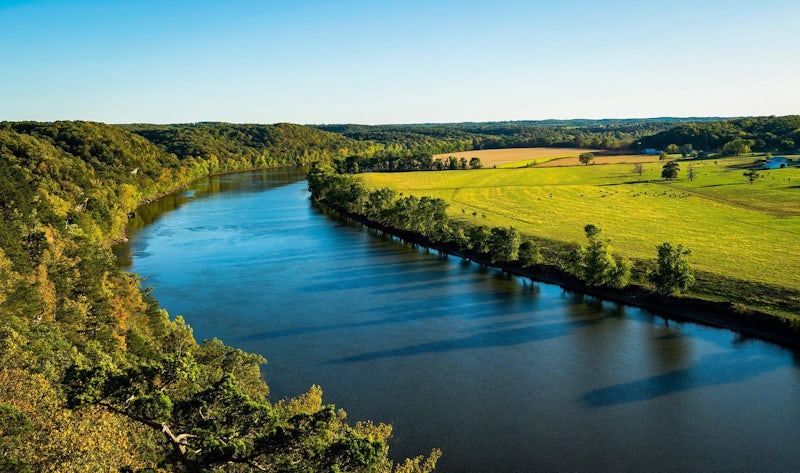The Osage River is a tributary of the great Missouri River in the central United States of America. It stretches 275 miles in length, is the 8th largest river in Missouri and boy does it have some stories to tell.
The Osage River name was derived from the Osage Nation indigenous people who once lived throughout the region and were present at the time of European settlement. It was formed by the natural coming together of the Marais des Cygnes (Marsh of the Swans) and Little Osage Rivers. Some consider the Marais des Cygnes to be part of the Osage and its inclusion expands its length to nearly 500 miles. Excluding it from the Marais, the Osage begins in southwestern Missouri, just north of the town of Nevada. Its course takes it east/east-northeast slicing its way through the Missouri Ozarks and some of the most breathtaking scenery imaginable, then through two dams all the way to its confluence with the Missouri River, the second-largest river in the northern hemisphere.
Early settlers to the area used the river often but were frustrated by its ever-changing conditions. With constantly shifting water levels, pools, sand bars and other miscellaneous obstacles, the river was widely-regarded in the region as more of a source of headaches than that of a navigable waterway. As a result, in 1839 the state attempted to deepen the channel. These early attempts failed because the river proved to be too tough to tame and funding for the project came to a halt. Further attempts in the 19th century to utilize the river for commercial navigation were somewhat successful, but confined to smaller craft that could navigate the shoals and tight bends of the river.
In 1805, the Lewis & Clark expedition stopped along the confluence of the Osage and Missouri Rivers on their journey into the vast western unknown. The expedition struggled against a strong current before stopping at the confluence. At night, the duo took celestial observations to determine the precise location of this important tributary.
At the mouth of the Osage, Clark was vexed by deer ticks and mosquitoes and was quoted as saying, “I have a very severe sore throat and am plagued by mosquitoes and small ticks”. Several of the crew successfully hunted four deer, while other members collected plant specimens such as ground plums and wild ginger.
Patrick Gass, a sergeant in the expedition who published the first journal of the its exploration said of the confluence, “…at 4 o’clock P.M., we arrived at the Osage River where we remained during the evening and the next day. The Osage Nation of Indians live about two-hundred miles upriver. They are of a large size and well proportioned and are a very warlike people. Our arms and ammunition were all inspected here and found in good order.”
In 1922, construction began on the Bagnell Dam to produce electricity for the booming city of St. Louis. After a decade of construction, the dam was completed and ended commercial navigation on the Osage River. A second dam, Truman Dam, was completed in 1979 as a part of the Flood Control Act of 1954 and serves to provide flood mitigation for southwestern Missouri.
The Osage River is a complex, thriving ecosystem with a natural diversity that both inspires the spirit of the outdoors and provides sustainment for the plants, animals and people that reside within its reach. With black bears, bison, bobcats, badgers, beavers, barreled owl and bobwhite quail, the river’s ecology is a natural resource for thousands of creatures (and those are just the ones that start with the letter “B”!). Additionally, over 100 species of fish navigate the mighty waters of the Osage.
On the human side of things, energy is harnessed through the two dams to produce enough power to fuel the lives of over 100,000 people a year, making it vital part of the commercial and natural landscape of the region. The endless array of fish, game and plant life provide a wealth of opportunities for fishing, hunting and foraging. The well-preserved nature is a hotspot for a breadth of outdoor activities the whole year-round.
At Osage River Gear, we take pride in the name we’ve affixed to our brand and to each and every piece of gear we offer. As a Missouri-based business, we are connected to the mighty Osage River in all of its splendor. Our gear is designed much like the river itself; it bridges form and function and facilitates the joy of being outdoors. Lastly, it’s tough. It’s as tough as the river that took a century to even begin to tame. With the same relentless energy as the Osage River herself, we offer products that inspire our community to navigate their adventures with confidence and ease.
We know you have options when it comes to your adventure gear, but we hope you’ll give us a try. We don’t just make this stuff. We’re all lovers of everything outdoors with hundreds of years of collective experience, so, simply put, we wouldn’t sell a single product that we wouldn’t (or haven’t) used ourselves. So give us a try! And feel the outdoors!



0 comments